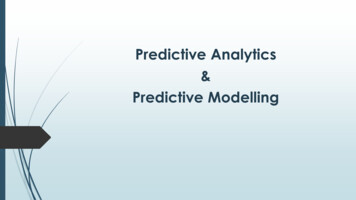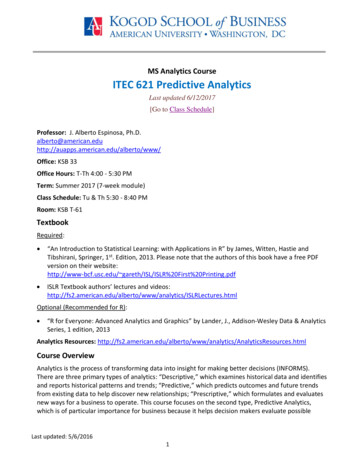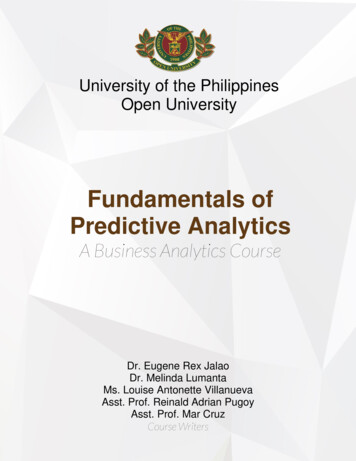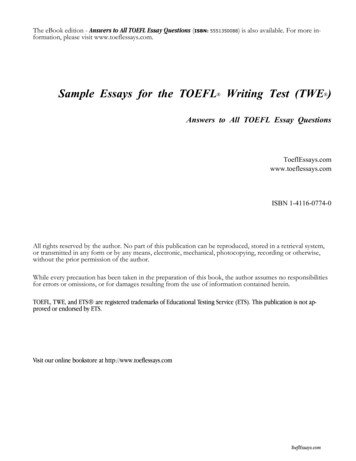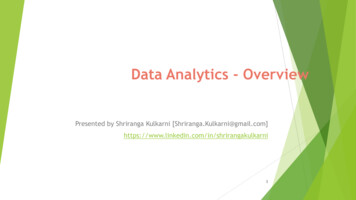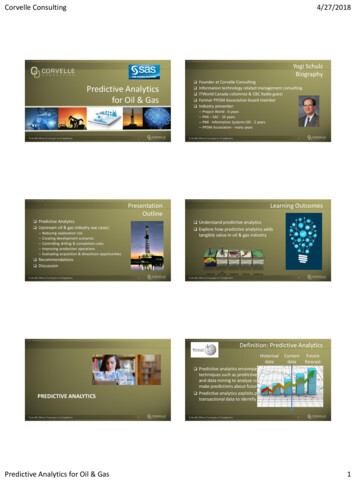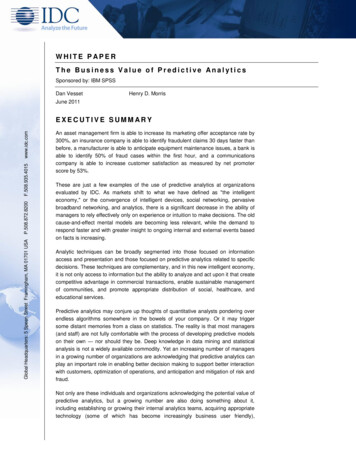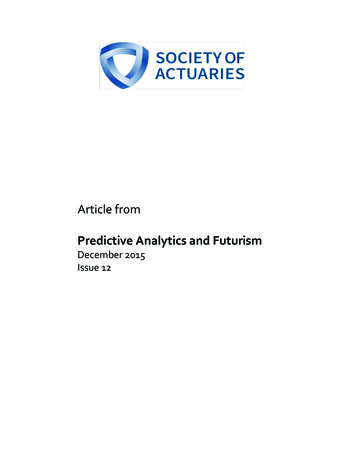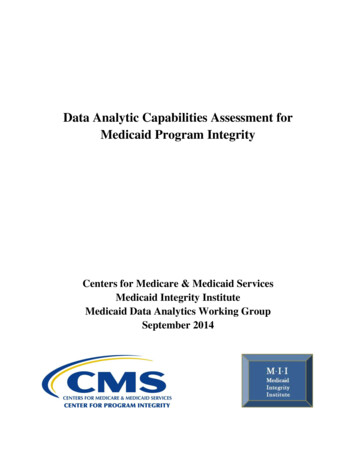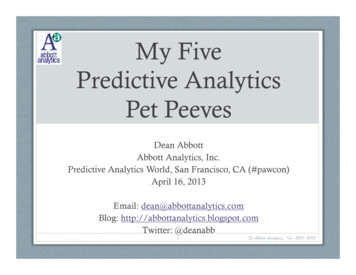
Transcription
Predictive Analytics2016 Call for EssaysAUGUST 2016
I’ve been fascinated by the broad and important worldwide decisions in recent months that have leveraged thepower of predictive analytics. Equity and currency exchange markets rose and fell as forward-looking modelsestimated the chances of the Brexit from the European Union. Business decision-makers in Canada beganestimating the outlook for privately sponsored pension plans as finance ministers looked to expand the CanadaPension Plan. And in the United States, it wouldn’t be the 2016 election cycle without a wide variety of predictivemodels using every new piece of information to estimate probabilities on a variety of outcomes. I’m guilty myselfof gleefully over-indulging on FiveThirtyEight podcasts to catch up on the most recent changes to general electionforecasts.It seems we’re to the point where not a day goes by that the topic of predictive analytics doesn’t come into ouractuarial conversations. With the growing amount of data continuously being generated on consumer behavior,analytics tools and methods continue to grow in importance for our profession. These methods have become moreengrained in how we determine prices for products, estimate future liabilities and help our businesses make betterdecisions. SOA meetings now routinely include more education and opportunity for actuaries to learn deeperconcepts in predictive analytics.As a continuing way to highlight how actuaries are using these concepts in practice, we invite you to read throughthe following collection of articles from our members. They provide additional insights into how actuaries are usingpredictive analytics to provide solutions in their work. Let us know your thoughts and share other examples ofpredictive analytics in action at the SOA Engage Research Community, our new online forum for discussing ideas.R. Dale Hall, FSA, CERA, CFA, MAAAManaging Director of ResearchSociety of ActuariesContents3 Comparing Policyholder Efficiencyin Variable Annuity LapsesJenny Jin, FSA, MAAA, andVincent Embser, ASA, CERA, MAAA6 Insurance ProductRecommendation SystemKailan Shang, FSA, CFA, PRM, SCJP9 Machine Reserving:Integrating Machine Learning IntoYour Reserve EstimatesDale Cap, ASA, MAAA13 Variable Selection UsingParallel Random Forest forMortality Prediction in HighlyImbalanced DataMahmoud Shehadeh,Rebecca Kokes, FSA, MAAA, andGuizhou Hu, MD, PhDThis publication is provided for informational and educational purposes only. Neither the Society of Actuaries nor the respective authors’ employers make any endorsement,representation or guarantee with regard to any content, and disclaim any liability in connection with the use or misuse of any information provided herein. This publicationshould not be construed as professional or financial advice. Statements of fact and opinions expressed herein are those of the individual authors and are not necessarilythose of the Society of Actuaries or the respective authors’ employers.Copyright 2016 Society of Actuaries. All rights reserved.2
ComparingPolicyholderEfficiency in VariableAnnuity LapsesJenny Jin, FSA, MAAA, andVincent Embser, ASA, CERA, MAAAIntroductionPeople are living longer and healthier lives. The need forretirement products to supplement retirement incomeis also increasing. The life insurance industry hasresponded to this increasing demand by offering a widearray of annuity products. In particular, variable annuityproducts have grown to become an important part ofretirement planning, due to the attractive benefit ofguaranteed lifetime income.There are many types of options embedded within avariable annuity contract. These range from productfeatures such as income guarantees to implicit optionssuch as the choice to keep or cancel the contract.Options are valuable to customers, and how customersuse these options provide important information forinsurance providers. In this article, we will study threecommon factors that actuaries use to formulate thelapse assumption for Guaranteed Lifetime WithdrawalBenefit (GLWB) policies and how predictive modelingcan help actuaries establish more appropriate lapsefunctions. Lapse behavior, or conversely persistencybehavior, is a key assumption in the pricing, valuationand risk management of variable annuity contracts.Given the embedded guarantees in the variable annuityproduct, the economic impact of lapses can vary basedon how valuable the guarantees are. Companies thatare better positioned to use data to understand howpolicyholders behave can ultimately gain an edge.Model FormsUnder the traditional framework used by companiesto set their assumptions, the lapse rate for a policy isassumed to follow a simple equation:Lapse Rate Base Lapse Rate Dynamic Lapse Factorwhere the base lapse rate is a function of the policy’sduration and the dynamic lapse factor is a functionof moneyness.Moneyness is defined as the ratio of guaranteed benefitvalue to account value. To set these assumptions,companies often rely on a tabular experience studyapproach or on their own judgment in situations wheredata are not available.Under a logistic predictive model framework, a numberof coefficients are jointly estimated for an underlyingdata set, and the model directly outputs lapseprobabilities as a function of a number of explanatoryvariables. The basic functional form of these predictivemodels is as follows:Lapse Rate Odds / (1 Odds)whereOdds exp(Intercept B1 Variable1 . Bn Variablen).Both traditional and predictive models account forthe effects of duration, moneyness and product type.However, the predictive model framework providesa statistically grounded method for estimating theseeffects together and can be readily expanded to includeadditional variables, as well as interactions betweenvariables. In addition to the duration and moneynessfactors, a predictive model can include other policy,demographic and macroeconomic variables. In thisarticle, we have focused on a simplified version of thepredictive model using just duration and moneynessfor comparison with the traditional model.DataThe “traditional model” referenced in this article is aset of pricing assumptions for a GLWB product with aseven-year surrender charge (SC), taken from a recentsurvey of variable annuity writers. Note that this modelis not representative of any single company but reflectsthe average assumptions for base lapse rates anddynamic lapse factors across a number of companies.The “predictive model” referenced in this article isbased on a Milliman study referred to in this paperas the VALUES1 model. For building the predictivemodel, we looked at quarterly lapse experience of1 Variable Annuity Lapse Utilization Experience Study3
Comparing Policyholder Efficiency in Variable Annuity LapsesGLWB products based on 21 million records from 12major variable annuity writers. We used a 70% randomsample of these records as a training data set to fit thepredictive model. We evaluated the predictability of themodel on the remaining 30% holdout data set.Comparison of Lapse ModelsDURATION EFFECTFigure 1 shows lapse rate predictions from these modelswhen applied to the seven-year SC policies in theholdout data set. The blue line gives the base lapse ratesfor a hypothetical at-the-money policy during the first15 policy years according to our representative industrymodel. The orange line shows the average lapse ratepredicted by the same model, but incorporating thedynamic effect from each record’s individual level ofmoneyness. This line is lower than the base lapse rate,as policies issued in the last 10 years emerged from the2008 global financial crisis and tended to be in-themoney over time, which reduced the predicted lapserates. The red line shows the actual lapse experienceobserved between 2007 and 2013. Finally, the greenline provide the lapse rates from our predictive model,aggregated across these same policies.One key observation is that the traditional modelproduces higher aggregate lapse rates for the shock year(the year immediately after SCs expire) and the post-SCyears. In particular, the post-SC aggregate lapse ratesfrom the predictive model are approximately 3 to 3.5%lower per year than rates from the average industryassumption. This could have significant implications forpricing and valuation, because the difference in annuallapse rates would be compounded over years.MONEYNESS EFFECTIf we hold all else equal and vary the moneynessvariable in our predictive formula, we can construct adynamic lapse curve for comparison with the industryassumption. Figure 2 shows this relationship.The slope of the dynamic lapse factors reflects theefficiency of policyholder behavior. This graph indicatesFigure 1 Aggregate Lapse Rates by DurationPredictions and Exposure Based on Holdout Data Set (30% of Total)18.0%16.0%Annualized Lapse Rate14.0%12.0%10.0%8.0%6.0%4.0%2.0%0.0%Years 1 to 4Years 5 to 7Year 8Years 9–15Predicted Lapses: Industry ATM Base Lapse RatePredicted Lapses: Industry Base Dynamic AssumptionPredicted Lapses: VALUES ModelActual Lapses4
Comparing Policyholder Efficiency in Variable Annuity LapsesFigure 2 GLWB Dynamic Lapse Relativeto MoneynessFigure 3 GLWB Dynamic Lapse BehaviorUsing Predictive Model200%Dynamic FactorDynamic Lapse 1.25In-the-Moneyness (BB/AV)GLWB Traditional ModelGLWB VALUES Model1.5BB/AVIn SC PeriodAfter SC PeriodShock Lapse Yearthat the traditional model (red line) assumes lowerdynamic lapse factors for policies both in- and outof-the-money, compared with the predictive model.That is, typical industry assumptions underestimatesensitivity for out-of-the-money policies andoverestimate sensitivity to in-the-money policies. Onaverage, the overall lapse rates predicted from theindustry assumption are higher than actual experience,as shown in Figure 1. This means that companiesare likely overestimating lapses despite adjustingfor dynamic behavior, and the true dynamics of howpolicies behave is potentially lost in the data.To illustrate this dynamic, we added interactions betweenthe in-the-moneyness variable and the three distinct SCphases. Figure 3 uses this expanded model to derivedynamic lapse curves for each phase (during in blue, endin red, after in green) of a seven-year GLWB product.Lapse Behavior During and After the SC PeriodIn future work, we will continue to explore these andother interactions and evaluate the significance oftheir effects. By analyzing policy behavior, companiescan gain further insights into how their customers areinteracting with their products. Doing this well willempower companies to use these insights for betterproduct development and in-force management.Some actuaries believe that policyholders do notbehave the same way when a SC is levied. If therelationship between a target variable and anexplanatory variable differs depending on the value ofanother explanatory variable, then there is aninteraction between the two explanatory variables. Oneof the most attractive aspects of a predictive modelingapproach, relative to the traditional model, is the easewith which this type of interaction relationship can beexplored and added to a model, arriving at credibleestimates. In a traditional framework, data insufficiencyacross multiple dimensions would preclude suchinteractions from being incorporated.This new model implies that policyholder behavior withrespect to moneyness varies across the life of the policy.In particular, policyholders seem to be most efficientat the end of their SC periods (red line). Within the SCperiod, policies are observed to behave inefficiently,which results in an inverted slope (blue line).Jenny Jin, FSA, MAAA, is a consulting actuary at MillimanInc. in Chicago, IL. She can be reached at jenny.jin@milliman.comVincent Embser, ASA, CERA, MAAA, is an associate actuaryat Milliman Inc. in Chicago, IL. He can be reached atvincent.embser@milliman.com5
Insurance ProductRecommendationSystemKailan Shang, FSA, CFA, PRM,SCJPRecommending an appropriate insurance productis important for insurers to acquire new businessfrom either a new client or an existing client. Theclient’s demographic and financial information isuseful for predicting the most wanted insuranceproduct type. With the right recommendation, theprobability of completing a sale will be higher andthe length of time to make a sale can be shortened.Traditionally, insurance agents have used householdfinancial planning to help clients choose insuranceproducts. However, it requires significant time, skilland experience on the agent’s part. Other distributionchannels such as telemarketing may not provide theopportunity to conduct such a complicated analysis forcustomers. On the other hand, insurance companieshold relevant information that is very helpful forpredicting the next likely sale to a client.Business CaseA life insurance company wanted to improve theeffectiveness of its selling efforts to reduce cost andincrease sales volume. The company has millionsof existing policyholders, and it had established apartnership with another financial institution thatallows cross-selling. Demographic information,purchase history, financial information and claiminformation on existing customers are available.The company was interested in knowing the mostlikely product that a client would purchase and theprobability that the sale would be completed.DataFive categories of data are used for the project:1.Demographic information including age, gender,address, ZIP code, smoker/nonsmoker, healthstatus, occupation, marital status and informationabout dependents2.3.4.5.Financial information including assets, realestate, income, loans and spendingPurchase history including product type, productname, issue age, face amount, premium rate, faceamount change, partial withdrawal, policy loanand product conversionClaim history including time, amount, payment, etc.Communication history including last contacttime, reason, outcome, complaints, etc.For categorical variables such as address, ZIP code andcommunication reasons, dummy variables are createdto represent them. The data are not complete for allclients. For missing demographic or financial data, thevalue in the most similar record is used. The similarity ismeasured by the Euclidean distance given byn(Yi — Xi )2 i li 1whereX is the data record with missing value for variable l.Y is a complete data record in the data set.n is the number of variables in the data set.ModelsGiven the large amount of explanatory variables and thecomplicated relationships, traditional linear andnonlinear regression models that require exact modelspecification are not suitable. An artificial neural network(ANN) model was chosen to estimate the probability ofnew insurance purchases. ANN models mimic humanneural networks, which are capable of makingcomplicated decisions with layers of neurons. ANNmodels can approximate complicated relationshipswhose model specifications are unknown. A multilayerfree-forward neural network model was used for theestimation. Figure 1 shows the model structure.Notes:1. A sigmoid function is used for specifying therelations between layers,1g(x) 1 e-x .2. Each node in the network is determined by theii–1i–1nodes in the previous layer, aj g ( 0j x a ) , whereaji is node j in layer I, and a i–1 is a column vectorincluding all the nodes in the previous layer, where0j i–1 is a row vector including the weights for all thenodes in layer i 1 for estimating aji .6
Insurance Product Recommendation SystemFigure 1 ANN Model Structurea 00a01a 20a 01a 021121aaa 21a 220a n–2a 31a 320a n–1a 41a 42a 03a 13a 23a n0Input g (1)DataHidden g (3)LayerHidden g (2)LayerOutputThe first layer is the input data. The second and thirdlayers are hidden layers. The fourth layer is the outputlayer, which comprises the probabilities of buying eachof three insurance products. Back-propagation withrandom initialization of model parameters is used totrain the ANN. For some nodes in the second layer, notall the input data (first layer) are used to determinetheir values. As shown in Figure 2, expert opinionsFigure 2 Heuristic Training for theSecond LayerDemographicInfoFinancial InfoPurchaseHistorya 01Affordabilitya 11Risk Appetitea 21Satisfactiona 31New Insurance NeedsClaim HistoryCommunicationHistoryare used to construct part of the second layer. Fournodes are used to represent the affordability, riskappetite, client satisfaction and new insurance needsdetermined by selected subsets of input data. Experts’inputs on the weights ( 0j0 , j 0 to 4) of input data forthe four nodes are used for parameter initialization. Theremaining node a41 in the second layer is assumed tobe affected by all input data to allow model flexibility.Some existing customers had already bought two ormore products. They are used as the positive examplesin the calibration and are the key to predicting thelikelihood of buying a second product and its mostlikely type. The data set was divided randomly intotraining data and validation data. The calibrated modelbased on the training data was validated using severalpractical approaches. For example, the ANN outputs fora customer who has bought a universal life (UL) productare that the customer has a probability of 80%, 30%and 50% to buy a new term life (TL), new UL andlong-term care (LTC) product, respectively. Therefore,the recommended product is TL. The 10 most similarcustomers with two or more products including at leastone UL product are sought. If no fewer than 50% (80%/[80% 30% 50%]) of the 10 customers have bought a TLproduct, the ANN model is considered reasonable. Thesimilarity is measured using Euclidean distance. Becauseof the large number of input variables, the impact ofimportant variables could be diminished by unimportantvariables if equal weights are applied. The four nodes inthe second layer (affordability, risk appetite, satisfactionand new insurance needs) are used instead to determinethe similarity of customers. Using the validation data,the model has a reasonable rate of 69%.The model was also validated using a pilot salesproject by contacting around 2,000 existing customerswith only one insurance purchase in the past. Thesecustomers are those with a high chance of purchasinga second product as predicted by the ANN model.The success rate of selling a second product is 4.5%compared to a past average level of 1.3% when theselection of contacted customers was based onqualitative analysis targeting high-net-worth clients.The 4.5% success rate is lower than expected based onthe model prediction, with possible reasons includingchanges in family and financial conditions and havingmade purchases with other insurers.7
Insurance Product Recommendation SystemResultsThe ANN model was used to estimate the most likelyproduct to be bought and the probability of completingthe new sale for each existing customer. The customerswere then ordered by the probability. Table 1 shows thepercentage of customers who will buy a product witha probability higher than a certain value based on themodel result. For example, 3% of the existing customerswill buy an LTC product with a probability of 50%.Using these results, existing customers can be contactedwith relevant product information. The cost can also bemanaged by limiting the selling efforts only to customerswith a high probability of completing the sale. The modelcan be further enhanced by estimating the cost and faceamount of a product that a customer is likely to accept.Table 1 ANN Result Summary for aSample Data C2%3%6%Kailan Shang, FSA, CFA, PRM, SCJP, is co-founder ofSwin Solutions Inc. He can be reached at kailan.shang@swinsolutions.com.8
Machine Reserving:Integrating MachineLearning Into YourReserve EstimatesDale Cap, ASA, MAAAgathering data and engineering features from the data,and building and evaluating the models. As in theactuarial control cycle, it is important to continuallymonitor results.Through our research, we have found significantimprovements in the prediction of reserves by employingthis ML process. Overall we have found a reduction inthe standard and worst case errors by 10%. To assistactuaries in testing the value of ML for themselves, thispaper will provide an outline of the ML process.Define the ProblemTwo hundred years ago a captain may have had only asounding line and his experience to navigate throughuncharted waters. Today a captain has access to manyother data sources and tools to aid in his navigation,including paper charts, online charts, engineeringsurveys, a depth sounder, radar and GPS. These newtools don’t make the old tools obsolete, but anymariner would be safer and more accurate in theirpiloting by employing all the tools at their disposal.In the same vein, actuaries who solely use traditionalreserving techniques, such as triangle-based methods,aren’t capitalizing on new technologies. Actuaries shouldstart adopting other techniques such as machine learning(ML). ML is a field of predictive analytics that focuses onways to automatically learn from the data and improvewith experience. It does so by uncovering insights in thedata without being told exactly where to look.ML is the GPS for actuaries. As GPS improvednavigation, ML has the potential to greatly enhanceour reserves. It is important to note though that ML isnot just about running algorithms; it is a process. At ahigh level this process includes defining the problem,Similar to the Actuarial Control Cycle, the first step is todefine the problem. In our context, we are interestedin efficiently calculating the unpaid claims liability(UCL). We want to calculate this quantity in an accuratemanner that minimizes the potential variance in theerror of our estimate.Actuaries often use various triangle-based methods suchas the Development and the Paid Per Member Per Month(Pd PMPM) to set reserves. These methods in principleattempt to perform pattern recognition on limitedinformation contained within the triangles. Although thesemethods continue to serve actuaries well, informationis being left out that could enhance the overall reserveestimate. To make up for the lack of information used toestimate the reserves, an actuary relies heavily on his orher judgment. Although judgment is invaluable, biasesand other elements can come into play, leading to largevariances and the need for higher reserve margins.As described in our prior article1, the range of reserveestimate error present in company statements pulledfrom the Washington State Office of the InsuranceCommissioner website was 10% to 40%. ThisFigure 1 Machine Learning ProcessDefine theProblemData & FeatureEngineeringModeling &EvaluatingResults1 Cap, Coulter, & McCoy, 20159
Machine Reservingrepresents a wide range of error and has significantimplications, including an impact to the insurer’srating status, future pricing and forecasting decisions,calculation of premium deficiency reserves, or evenunnecessary payout of performance bonuses.Data and Feature EngineeringGathering data is something that actuaries are alreadygood at. Leveraging off their expertise along with othersubject matter experts will be helpful in identifying allavailable sources for use. There is often a saying withML that more data often beat a sophisticated algorithm.Once the data have been gathered, the actuary willneed to engineer the data to improve the model’spredictive power. This is referred to as featureengineering and can include the transformation,creation, conversion or other edits/additions to thedata that will benefit the process. As an example,suppose we were estimating the cost of a housewith only two fields: the length and the width of thehouse. We could help improve the model by featureengineering a new feature called square footage, wherewe would multiply the length and width.The gathering and engineering of the data can be a difficultstage to get through, and without the right people on theteam, it could lead to a wasted effort. Having domainknowledge on the team enables a more thoughtfulconsideration of what sources and features are important.In our research we have found many features that havepredictive power for reserve setting. The following is asample list of features that could provide value: SeasonalityNumber of workdaysCheck runs in a monthLarge claimsInventoryInpatient admits/daysMembership mix by productChange in durationCost-sharing componentsDemographicsPlace of serviceModeling and EvaluatingOnce the data have been prepared, the user will applyvarious ML models to the data set. In general, there aretwo types of data: the training set and the testing set.Figure 2 Supervised Machine LearningIncurredMonthLagArea MonthWorkdaysCheckRunsIncurred Age/Inventory & PaidGenderOtherActualFeatures IncurredJan -10xxxxxxxx250.00Jan -10xxxxxxxx240.00Jan -10xxxxxxxx265.00Jan -10xxxxxxxx280.00Jan �——Dec -11xxxxxxxx335.00Dec -11xxxxxxxx305.00WorkdaysCheckRunsxxIncmoDec -12LagArea MonthxxMLModelIncurred Demo- OtherExpectedInventory & Paidgraphic Features Incurredxxxx250.0010
Machine ReservingThe training set is the data used to train and crossvalidate the model and comprises historical data (inthe case of reserving, historical completed data). Thetesting data on the other hand include only the datafrom which you wish to derive predictions (for example,the current month’s reserve data).These results were then compared against typicaltriangle-based methods, where we tested the percentagerange of UCL error over 24 different reserving months.Overall we found that ML added significant value inreserve setting, and we highly encourage reservingteams to explore this process for themselves.To evaluate the model, a portion of the training set iswithheld in order to cross-validate the results. The modelsthat are identified to perform well on the withhold set arethen applied to the testing data to create the predictions.ConclusionPredictive analytics are not new to actuaries. Methodslike these are fairly common on the casualty side andhave recently become more popular within health carefor predicting fraud, readmission and other aspects.However, those within health care are often being ledby data science teams, who continue to fill a largeranalytics role within the health space. It is only a matterof time before these techniques become standard toreserving. The question is: Who will fill this role? Willactuaries stay at the helm, or will we transfer some ofour functions to data science teams?There are many different machine learning models, eachof which has its own strengths and weaknesses. Thusthere is no one model that works best on all problems.ResultsFor our research we used supervised learning techniquesclassified as regression. We ran various ML models anddetermined which ones were the most appropriate forthe problem based on cross-validation techniques. Wethen used an ensemble method to blend the variousmodel outputs for an overall prediction. An example ofthis type of technique can be found in our prior article2.We hope that the process outlined above will providesome guidance and at least prepare actuaries for theirfirst steps in this space.Figure80% 3 UCL Prediction Error Range (Box and Whisker Plot)60%Prediction Error Range40%20%0%xxxxxxModel 1Model 2xxModel 5Linear Stacking–20%–40%Paid PMPMDevelopmentModel 3Model 4–60%Triangle BasedMachine Learning ModelsEnsemble2 Cap, Coulter, & McCoy, 201511
Machine ReservingAppendixTriangle BasedStatisticsMean ErrorStandard ErrorKurtosisSkewCumulative ErrorWorst ErrorPaidPMPMMachine Learning ModelsDevelopment Model 1Model 2EnsembleModel 3Model 4Model 7.6%49.1%57.7%29.0%41.1%28.5%31.4%27.0%25.3%Dale Cap, ASA, MAAA, is an actuary with a passion foranalytics. He can be reached at dale j cap@outlook.com.12
Variable SelectionUsing ParallelRandom Forestfor MortalityPrediction in HighlyImbalanced DataMahmoud Shehadeh,Rebecca Kokes, FSA, MAAA andGuizhou Hu, M.D., Ph.D.In the last few years, the industry has startedmoving away from traditional actuarial methodstoward more statistically sound methodologiesincluding parametric and nonparametric approachessuch as generalized linear models and machinelearning algorithms to better assess risks. Usingsuch techniques and utilizing the full potential ofunderwriting data can improve mortality predictiongreatly. In the life insurance industry, actuaries andunderwriters need to process a substantial amount ofdata in order to assess the mortality of applicants asquickly and accurately as possible. Examples of suchdata include, but are not limited to, demographic,paramedic and medical history. The data can benumerical (age, face amount), categorical (gender,smoking status) and even free text. However, usingsuch data is not always straightforward.In this article we present a practical example of theintersection of life insurance, machine learning and bigdata technology. The aim is to use a random forest (RF)algorithm to identify the most important predictors(from a set of hundreds of variables) that can be usedin mortality prediction, that is, to reduce number ofvariables from hundreds to dozens while retainingthe predictive power. In addition, the use of parallelcomputing to speed the process and stratified samplingto deal with highly imbalanced data is discussed.1The medical history of applicants includes hundreds,if not thousands, of unique keywords that have thepotential to increase the accuracy of risk assessment.Typically, one can include this information as predictorsin regression analysis following two approaches: first,by manually selecting the most important terms
predictive analytics to provide solutions in their work. Let us know your thoughts and share other examples of predictive analytics in action at the SOA Engage Research Community, our new online forum for discussing ideas. R. Dale Hall, FSA, CERA, CFA, MAAA Managing Director of Research Society of Actuaries 3 Comparing Policyholder Efficiency
